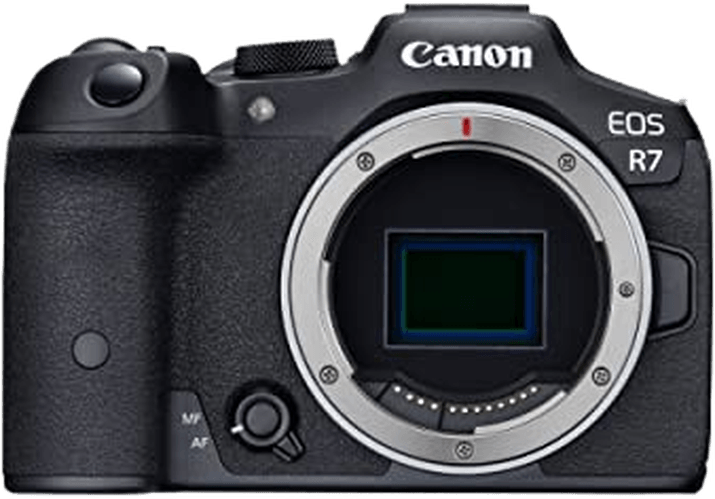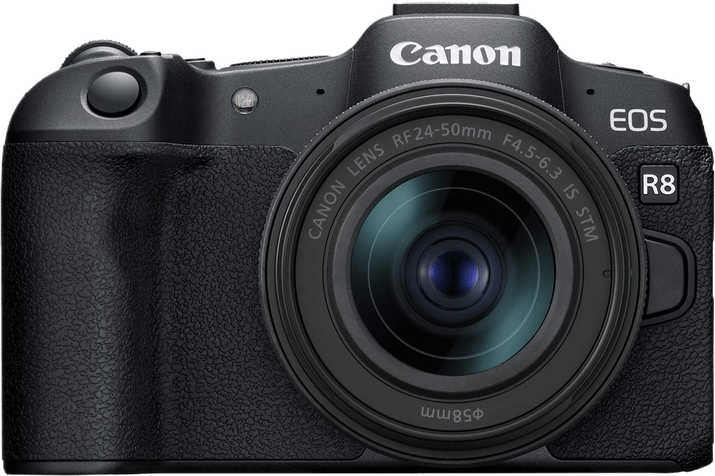Canon EOS R7 vs EOS R8 Comparison
Canon EOS R7

Canon EOS R8

The Canon EOS R7 takes the lead with a score of 83/100, while the Canon EOS R8 follows with 76/100. Both cameras are mirrorless and were launched in 2022 and 2023, respectively. They share a similar price range, with the R7 at $1500 and the R8 at $1499.
The R7’s advantages include a larger body, measuring 132 x 90 x 92mm, and a heavier weight of 612g (1.35lbs). This could provide better stability and grip for some users. On the other hand, the R8 is smaller and lighter, with dimensions of 133 x 86 x 70mm and a weight of 461g (1.02lbs), making it more portable and easier to carry for extended periods.
Despite having a lower score, the R8’s compact size and lighter weight might be preferable for some photographers. However, the R7’s higher score and larger build could offer better overall performance and handling. Ultimately, the choice between these two cameras depends on individual preferences and shooting needs.
Canon EOS R7 vs EOS R8 Overview and Optics
The Canon EOS R7 wins the optics comparison with a score of 82/100, while the Canon EOS R8 scores 77/100. Both cameras share common specifications such as CMOS sensor type, Digic X processor, and Canon RF lens mount.
The EOS R7 has a higher megapixel count at 33 compared to the R8’s 24, providing better resolution and image quality. Its sensor size is APS-C, and it has a DXOMARK score of 97 for its sensor performance. Additionally, the R7 offers image stabilization, which reduces camera shake and enhances the sharpness of images.
On the other hand, the EOS R8 has a significantly higher shooting speed of 40 compared to the R7’s 15, allowing for better performance in capturing fast-moving subjects. However, it has a lower DXOMARK score of 94 for its full-frame sensor and lacks image stabilization.
The R7’s higher megapixel count and image stabilization make it a better choice for photographers who prioritize image quality and stability. Its APS-C sensor size and higher DXOMARK score showcase its superior optics performance.
Conversely, the R8’s faster shooting speed makes it more suitable for action and sports photography. Its full-frame sensor size can also offer a wider field of view and better low-light performance. However, the lack of image stabilization may limit its versatility in certain shooting situations.
In the optics comparison, the Canon EOS R7 emerges as the winner due to its higher score, better resolution, and image stabilization. The EOS R8, while having a faster shooting speed and full-frame sensor, falls short in overall optics performance.
Canon EOS R7 vs EOS R8 Video Performance
The Canon EOS R7 and Canon EOS R8 both receive a video score of 91/100, indicating that they are equally capable in terms of video performance. Both cameras share common specifications, such as 4K max video resolution, 3840 x 2160 max video dimensions, and built-in time-lapse functionality.
Despite the identical scores, the EOS R8 has a higher max video frame rate at 180fps, compared to the EOS R7’s 120fps. This difference allows the EOS R8 to capture smoother slow-motion footage, which is particularly useful for videographers who require more flexibility in post-production.
On the other hand, the EOS R7 does not offer any significant advantages in video capabilities over the EOS R8. Both cameras have the same video resolution, dimensions, and time-lapse functionality. Therefore, the EOS R7 does not outperform the EOS R8 in any specific video aspect.
Considering the video capabilities of both cameras, the EOS R8 is the better choice for those seeking higher frame rates for slow-motion footage. However, the EOS R7 still provides excellent video performance with its 4K resolution, time-lapse functionality, and 120fps frame rate. Ultimately, the choice between the two cameras will depend on individual needs and preferences, as both deliver impressive video capabilities.
Canon EOS R7 vs EOS R8 Features and Benefits
The Canon EOS R7 and Canon EOS R8 both have a feature score of 85/100, making them equal in this aspect. They share several specifications, including a 3-inch screen size, screen resolution of 1,620,000 dots, and touchscreen capabilities. Both cameras also have a flip screen, GPS, WIFI, and Bluetooth features.
Since both cameras have the same score, it is crucial to examine the individual specifications to determine which camera is better. The EOS R7 and R8 have identical screen sizes, resolutions, and touchscreen capabilities, which means that they provide the same user experience when navigating menus and reviewing photos. Additionally, both cameras have flip screens, which are beneficial for capturing images and videos from various angles.
The absence of GPS in both cameras is a drawback, as it would be useful for geotagging photos. However, the WIFI and Bluetooth features in both cameras make transferring and sharing images more manageable. It is worth noting that these cameras do not have any distinct advantages over each other, as their specifications are the same.
To conclude, the Canon EOS R7 and EOS R8 are evenly matched in terms of features, with neither camera having a clear advantage over the other. Both cameras offer the same user experience and connectivity options, making it difficult to determine a winner based solely on their specifications. Ultimately, choosing between these two cameras will come down to personal preference and other factors such as price, performance, and intended use.
Canon EOS R7 vs EOS R8 Storage and Battery
The Canon EOS R7 outperforms the Canon EOS R8 in storage and battery, scoring 79/100 compared to the R8’s 35/100. Both cameras accept SD, SDHC, and SDXC memory cards and offer USB charging. However, the R7 has notable advantages over the R8.
The EOS R7 provides two memory card slots, while the R8 only has one, allowing for greater storage capacity and flexibility in the R7. The R7 also exclusively supports UHS-II compatible cards, ensuring faster read and write speeds. Additionally, the R7 boasts a significantly longer battery life, with 660 shots per charge compared to the R8’s 370 shots. The R7 uses the LP-E6NH battery, which is more powerful than the R8’s LP-E17 battery.
The R8 does not have any advantages in storage and battery over the R7. Its single memory card slot and shorter battery life make it less convenient for extended use.
Given these differences, the Canon EOS R7 emerges as the superior choice for photographers who require ample storage and longer battery life. Its dual memory card slots and extended battery capacity make it a more practical and reliable option than the Canon EOS R8.
Canon EOS R7 vs EOS R8 Alternatives
Are you considering buying or upgrading from a Canon R8 or R7? Our camera comparison tool can help you weigh up its price and performance against the competition.
Here are some related popular camera comparisons to check for inspiration:
